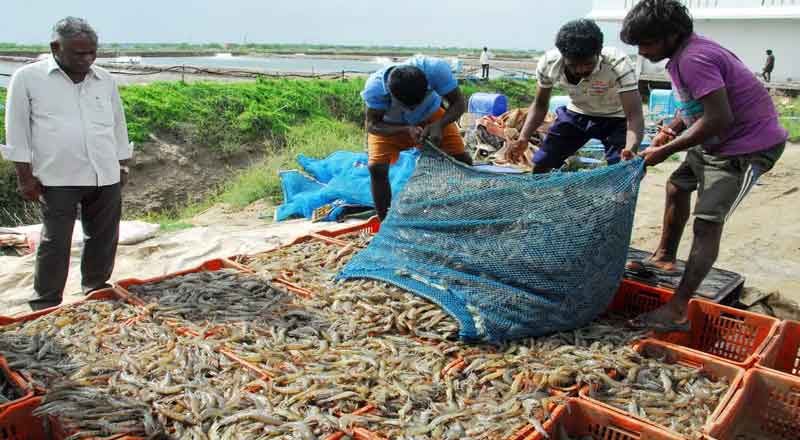(A field report on the lives of fishermen in Odisha’s fishing hub at Balugaon)
Balugaon, a small town in the Khordha district of Odisha has been its economic core for years now. The place has a humble occupancy of 3,735 families with a population size of 17,645(Census 2011). It is not difficult for any stranger entering its vicinity to guess the line of business in Balugaon – the strong smell of fish and the hustle-bustle of the fishing community detest and allure at the same time. Balugaon’s flourishing prawn and fishing industry has contributed hugely to Odisha’s placement as the 4th largest contributor to India’s fish production industry.
Balugaon’s close proximity to the famous Chilika lake with its brackish water lagoon provides a rich source of biodiversity. Its fishing industry – based on the marine life of Chilika lake – had a fish, crab, and prawn yield of 12950 million tons from 2020-21. The credits of this yield go to its fishermen who not only sell their catch in the local market, but also export to other big cities like Delhi, Mumbai, Kolkata, and Chennai. These fishermen rely on the diverse marine life that hides beneath the waves of Chilika lake for their daily earnings by selling a variety of types and sizes of fish.
Fish and Fishermen
Balugaon’s fishermen enter the lake in groups of 10-12 people in small fishing boats every day. By spending long hours, they are able to catch a plethora of fish such as hilsa, bhetki, pamphlet, crabs, and prawns all year long. The collected fish are then divided into 5-6 categories before being sold at different rates. The fishers enjoy the liberty of assigning their own price to their catch primarily due to the government’s stance of non-intervention. Here, the supply-demand concept also plays a role in the pricing – if the quantity of the catch is more, the price of fish is lowered. The prices also vary based on the species and size of the catch. For instance, a big crab can be ₹1500+ for one kilogram. Most of the wholesalers here have 4-5 people (mostly family members) who support them in dealing with exports to other cities apart from selling in the local market.
However, despite this flourishing network and the direct access to natural resources, the members of the fishing industry here, in Balugaon, face several hardships.
Risks in fishing
Fishers go into Chilika lake early morning or in the evening, only to return after 12 long hours. They go approximately 30 km into the lake if they have smaller boats and 40km with bigger boats. Here, in the middle of the lake, they have no safety facilities.
Ramesh Behera, a local fish wholesaler, states that in the event of strong winds or even cyclones, there is no nearby land for fishers to revert to. He says the only land they can access when in the midst of the lake is a location called the “Nalbana Bird Sanctuary”, which fishers are not allowed in as per government regulations. Thus, with no safety mechanism in place these fishermen risk their lives every time they are out in waters, and more so in times of storms and cyclones.
Financial Instability
Odisha being a cyclone prone state, Balugaon faces the brunt of it due to its proximity to and business dependence on the water body. Fishers often fall victim to damaged homes, market areas, equipment,
and even loss of their lives. While the government offers money as reparations of physical property damage, the fishers per say do not receive any monetary compensation for the days of business lost due to these natural disasters. For instance, after the cyclone Fani of 2019, at the outer canal of Chilika lake, close to 90% of the fishing boats and nets were damaged. During this time, the village was evacuated 5 days prior and fishermen were restricted from entering Lake Chilika for approximately 10 days thereafter. During this time, while the fishers were given shelter at nearby school buildings and were served simple food like rice, dalma, poha, and tea, their earnings received a severe setback. Similarly, in any given year, apart from nature’s bite, Balugaon fishermen lose a major chunk of their income due to the Odisha government’s ban on deep sea fishing for 2 months to facilitate fish breeding to conserve the fisheries resources.
This break in work and income has been a consistent problem in their lives which they can do nothing about. As sea surface temperature (SST) rises in the Bay of Bengal, and the Chilika lake, the prevalence of these cyclones becomes more of a concern since the number and magnitude of these cyclones are predicted to increase. Such weather forecasts cast an even darker shadow in the lives of these fishermen who take such news with bated breath and helplessness.
As such, these fishermen struggle to make minimum wage, earning only ₹3 to ₹5 in commission for each kilogram of fish sold. Thus, even small breaks in their work have a profound impact on their household incomes and overall welfare. Chandan Mondol, working for a fish trader in Balugaon, makes approximately ₹200 per day and states that this is simply insufficient to support his family.
The daily uncertainty of the catch further adds woes to fishermen’s lives. There’s no guarantee of the quantity and type of fish that these fishermen will obtain when they enter the lake. Hence, there is always a luck factor that presides over their lives no matter how hard they work. Along with this, the diversity of Chilika lake, overtime, is reducing as some species are in decline such as Mugil cephalus (locally called Khainga), Daysciaena albida (locally called Boroga) and Eleutheronema tetradactylum (locally known as Sahala). With these kinds of fluctuations in not only weather, but also the types of fish available, fishers struggle to meet their livelihood.
Fishing as the only career option
One would think, with the many challenges that the fishing community in Balugaon faces, it would make sense to leave and resort to other careers. However, upon speaking to the fishers, it becomes evident that no matter what, they do not have the privilege to leave their line and find a new one. The main reason being the comfort of the ‘known livelihood’, which is mostly passed down through generations. Also, most of them do not even possess the money needed to create a shift in their jobs, leaving them stuck in the doldrum. With the scarcity of any better work options, the Balugaon fishing community has made their entire lives revolve around the fishing industry. Their homes surround the lake, the hospitals they visit are near the fish market, the schools they send their children to are also in the same area. Hence, fishing has become an ingrained part of their identity.
When asked about any change they see among their young generation, we are told that while some educated parents send their children to school, it is still treated as a privilege and not a right. Students who do not perform well in school are removed from the school to enter the fishing business at a young age. Nonetheless, one initiative taken by the government has helped to encourage higher education. Stipends are offered to students based on the results of their board exams in the 10th grade. If their marks are above 50%, they are given ₹3000. If their marks are above 60%, they are given ₹5000. If their marks are above 70% they are given ₹7000. Although this does serve to provide some sort of incentive, it does nothing for students from grades 1-10 who are often taken out of school at
an early age. Furthermore, the environment of the children of fishers is limited only to the fishing industry, thus making it seem like the only resort for them. This perpetuates the same cycle of life and poverty.
No technological advancements
Fishers in Balugaon use regular fishing nets to fish manually as opposed to any technology that could enhance their ability to get larger quantities of fish and with more ease. This traditional method of fishing is likely to continue as introducing any machinery would threaten the employment opportunities of the poor. This choice of technical advancement vs mass employment has made the locals choose the latter to support the communal good.
What fishers want from the government
Muralidhar Behara is the Founder & Secretary of Chilika Matsyajibi Mahasangha, a fisherfolk’s association. Upon speaking with him, the general demands of the fishing community of Balugaon became apparent.
The first key request was to provide financial compensation for the days of cyclones and fish breeding time when fishers simply cannot work. He expresses the need for not only physical damage compensation, but also for the loss of earning that is crucial for their survival.
He further shares the concern over the decline of catch per effort and the need to attach fiberglass reinforced plastic in traditional boats to increase the range of the boat to sail deeper into waters for a better catch of fish. He states the current cost of this needful gadget is ₹10,000, which is beyond the fishermen’s ability to pay. He suggests that if the government provides a 50% subsidy to buy it, many fishermen can reap its benefit.
Additionally, as a result of the decline in fish production, there has been a drop in household incomes, leaving many fishers in need of loans to sustain themselves and their families. He says the government should look into these loans in order to improve the quality of life for fishers.
In terms of schooling of children in the locality, his ideas are two-fold. Firstly, he says that the stipend given should be increased by ₹2000 for added incentives and also to cover the rising
costs of higher education. The other aspect he mentions is the much-needed incentives to attend school for grades 1-10. He believes the government should give some sort of financial support here to motivate fishers to provide basic education to their children.
Balungaon’s image of a thriving fishing hub is somewhat marred by the plight of these fishermen who are fighting odds to fill the plates of millions. How and who can help them are the questions that have long plagued their minds.
Research & written by – Diya Mati, Grade 11 Student, Dhirubhai Ambani International School, Mumbai.





